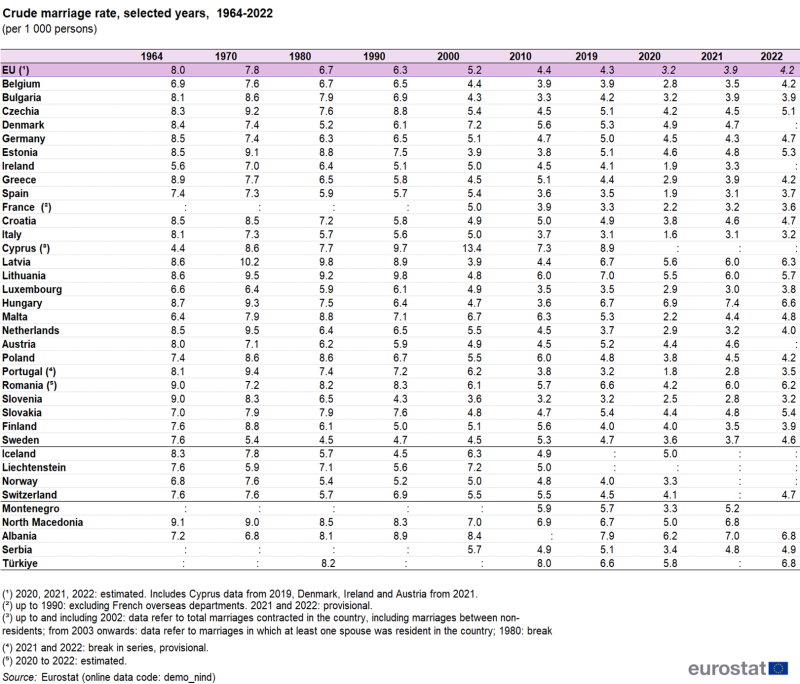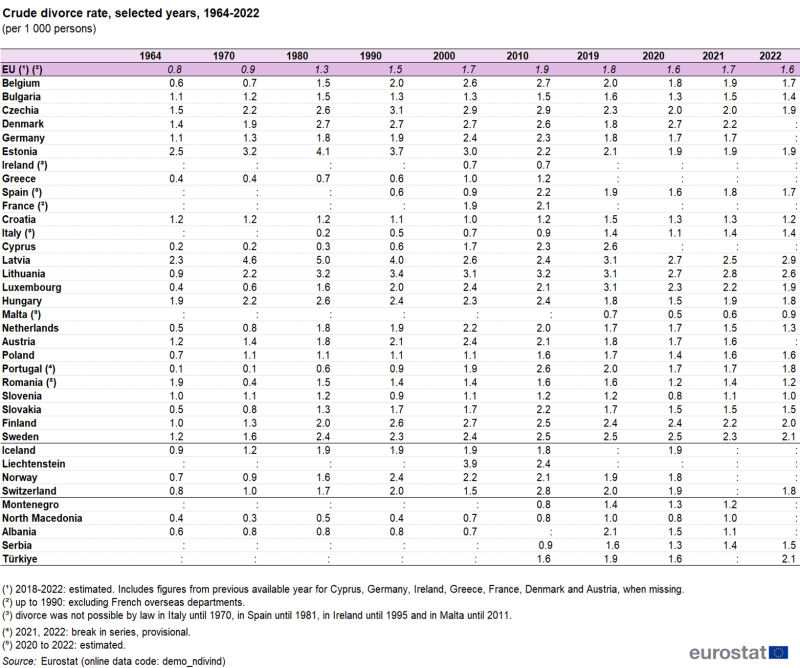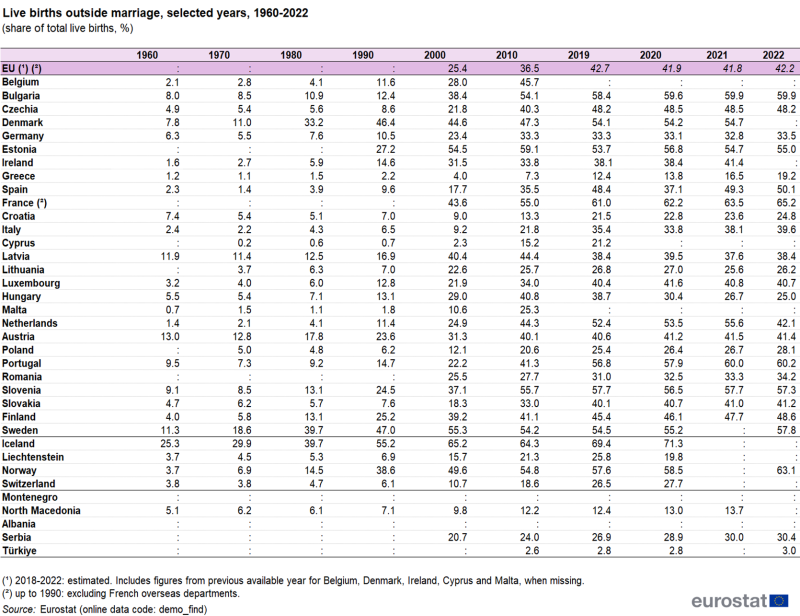Marriage and divorce statistics
Data extracted in March 2024.
Planned article update: March/April 2025.
Highlights
In 2022, the lowest crude marriage rates within the EU were reported in Slovenia, Italy (both 3.2 marriages per 1 000 persons), and Portugal (3.5).
In 2022, the highest crude marriage rates within the EU were reported in Hungary (6.6 marriages per 1 000 persons) and Latvia (6.3).
In 2022, the highest crude divorce rates within the EU were reported in Latvia (2.9 divorces per 1 000 persons), Lithuania (2.6) and Sweden (2.1).
In 2022, births outside marriage outnumbered births inside marriage in 7 EU Member States with available data: Bulgaria, Estonia, Spain, France, Portugal, Slovenia and Sweden.
This article presents developments that have taken place in relation to family formation and dissolution through an analysis of marriage and divorce indicators. Marriage, as recognised by the law of each country, has long been considered as marking the formation of a family unit. However, an analysis of trends in family formation and dissolution based just on marriage and divorce data does not offer a full picture. Legal alternatives to marriage, such as registered partnership, have become more widespread and national legislation has changed to confer greater rights on unmarried couples.
The number of marriages per 1 000 persons decreased within the EU in recent decades, while the number of divorces increased. However, both of these trends seem to have slowed in recent years. An increase in the proportion of children who are born to unmarried couples was also observed.
Full article
Fewer marriages, fewer divorces
Some 1.9 million marriages and an estimated 0.6 million divorces took place in the EU in 2022, according to the most recent data available for the EU Member States. These figures may be expressed as 4.2 marriages for every 1 000 persons (in other words the crude marriage rate) and 1.6 divorces for every 1 000 persons (in other words the crude divorce rate).
Since 1964 (the first year for which data are available), the crude marriage rate in the EU has declined by almost 50 % in relative terms (from 8.0 per 1 000 persons in 1964 to 4.2 in 2022). The downward trend is interrupted by some intermediate peaks in 1989 (6.4), 2000 (5.2), 2007 (5.0) and 2018 (4.5). The substantial decrease observed between 2019 (4.3 per 1 000 persons) and 2020 (3.2) in the crude marriage rate could be interpreted as an effect of the COVID-19 pandemic, representing a fall of almost 25%. Since then, and from 2021 onwards, a significant uptick can be observed in the crude marriage rate reaching 4.2 in 2022. Over the same extended period, the crude divorce rate has essentially doubled, increasing from 0.8 per 1 000 persons in 1964 to 1.6 in 2022. The divorce rate peaked in 2006 (2.1) and has been declining slightly since then. Part of this increase may be due to the fact that in several EU Member States divorce was legalised during this period (for example, in Italy, Spain, Ireland and Malta). The beginning of the COVID-19 pandemic seems to have impacted the divorce rate as well, as can be seen by the slight drop taking place between 2019 and 2020. Nevertheless, the decrease in the crude divorce rate was far less pronounced (about 10 %) than the one observed for the crude marriage rate. Since then that value has remained almost unchanged.

(per 1 000 persons)
Source: Eurostat (demo_nind) and (demo_ndivind)
Table 1 shows that in 2022, the highest crude marriage rates were in Hungary (6.6 marriages per 1000 persons), Latvia (6.3) and Romania (6.2). The lowest crude marriage rates were reported in Slovenia, Italy (both 3.2 marriages per 1 000 persons) and Portugal (3.5). Individual country figures reveal that in some EU Member States the lockdowns imposed by the emergency situation in 2020 caused marriage rates to drop by more than 50 %, e.g. in Ireland (4.1 in 2019 versus 1.9 in 2020) and Malta (5.3 in 2019 versus 2.2 in 2020). By contrast, the only country where the crude marriage rate increased during the first year of the pandemic was Hungary (6.7 in 2019 versus 6.9 in 2020). Since then, the trend seems to be going back to the pre-pandemic situation in most Member States, in particular when comparing the situation in 2019 to the one in 2022. Among those EU countries where data are available 8 Member States (Belgium, Estonia, Spain, France, Italy, Luxembourg, the Netherlands and Portugal) recorded higher crude marriage rates in 2022 than in 2019.

(per 1 000 persons)
Source: Eurostat (demo_nind)
For divorce (see Table 2), in 2022 the lowest crude rates in the EU were registered in Malta (0.9 divorces per 1 000 persons), Slovenia (1.0), Croatia and Romania (both 1.2). By contrast, divorce rates were highest in Latvia (2.9 divorces per 1 000 persons), Lithuania (2.6) and Sweden (2.1). As mentioned previously, the impact of the COVID-19 pandemic on the crude divorce rate was far less dramatic than on the crude marriage rate. As a consequence, in most Member States the crude divorce rate dropped slightly between 2019 and 2020. One EU country, Denmark, recorded an increase in this period, with 1.9 divorces per 1000 persons in 2019 increasing to 2.7 in 2020. Looking at the larger picture between 2019 and the latest available data in 2022, the crude divorce rate was lower in 2022 than in the last pre-pandemic year 2019 with the exception of Malta where that indicator went up from 0.7 to 0.9 divorces per 1000 persons.

(per 1 000 persons)
Source: Eurostat (demo_ndivind)
<sesection>
A rise in births outside marriage
The proportion of live births outside marriage has shown an increasing trend in the past decades, more than doubling since 1993 (17.7 %) when these data were first available in the EU. In 2022 this proportion was estimated at 42.2 % (see Table 3), meaning that 57.8 % of children were born inside marriage. This share reflects changes in patterns of family formation alongside the more traditional pattern where children were born within marriage. Extramarital births occur in non-marital relationships, among cohabiting couples, to lone parents and in registered partnerships.
Extramarital births outnumbered births inside marriage in seven of the EU Member States for which data are available, notably France (where 65.2 % of births occurred outside marriage), Portugal (60.2 %), Bulgaria (59.9 %), Sweden (57.8 %), Slovenia (57.3 %), Estonia (55.0 %) and Spain (50.1 %). Greece was at the other end of the spectrum where more than 80 % of births occurred within marriage.

(share of total live births, %)
Source: Eurostat (demo_find)
Looking at the latest available data, extramarital births increased in 14 of the available EU Member States in 2022 compared with 2021, remaining unchanged in Bulgaria. On the other hand, the indicator decreased between 2021 and 2022 in six Member States, the highest decrease can be observed in the Netherlands (from 55.6 % in 2021 to 42.1 % in 2022).
The COVID-19 pandemic does not seem to have impacted the percentage of babies born outside marriage. In 2020 at EU level, a slight drop was observed when compared to 2019, from 42.7 % to 41.9 %. Nevertheless, during the same period that rate increased in 19 Member States for which data are available, albeit with small margins, with the largest rise observed in Estonia from 53.7 % in 2019 to 56.8 % in 2020. In contrast, 5 Member States saw a decrease of the rate of live births outside marriage between 2019 and 2020, notably Germany (from 33.3 % to 33.1 %), Spain (from 48.4 % to 37.1 %), Italy (from 35.4 % to 33.8 %), Hungary (from 38.7 % to 30.4 %) and Slovenia (from 57.7 % to 56.5 %). Comparing 2022 to the last pre-COVID-19 year 2019, the rate of live births outside marriage was rising in all but 4 Member States, namely Lithuania, Hungary, the Netherlands and Slovenia where rates dropped. The biggest drop was recorded in Hungary (38.7 % in 2019 and 25.0 % in 2022) and the Netherlands (52.4 % in 2019 and 42.1 % in 2022).
Source data for tables and graphs
Data sources
Eurostat compiles information on a wide range of demographic data, including data on the number of marriages by sex and previous marital status and statistics relating to the number of divorces. The most recent data available for marriages for Cyprus are from 2019. Moreover, for 2022, no data on marriages were available for Denmark, Germany, Ireland and Austria. On the other hand, for divorces the latest data for Cyprus were available in 2019, 2017 for Ireland and Greece, and 2016 for France. In addition, in 2022 no data on divorces were available for Denmark, Germany and Austria. Data on the number of live births according to the mother’s marital status may be used to produce an indicator that shows the proportion of births outside marriage. The most recent data available for Belgium is 2018, for Cyprus 2019 and for Malta 2017. Moreover, no data on live births outside marriage were available for Denmark and Ireland.
Context
The family unit is a changing concept: what it means to be a member of a family and the expectations people have of family relationships vary with time, making it difficult to find a universally agreed and applied definition. Legal alternatives to marriage, like registered partnerships, have become more widespread and national legislation has changed to confer more rights on unmarried and same sex couples. Alongside these legal forms, other forms of non-marital relationships have appeared, making it more difficult for statisticians to collect data within this domain that can be compared across countries.
Due to differences in the timing and formal recognition of changing patterns of family formation and dissolution, these concepts have become more difficult to measure in practice. Analysts of demographic statistics therefore have access to relatively few complete and reliable data sets with which to make comparisons over time and between or within countries.
The EU has been going through a period of demographic and societal change. The outbreak of the COVID-19 pandemic, in 2020, will have a lasting impact on the way we live and work together. The outbreak came at a time when Europe had already been going through a period of profound demographic and societal change. On 17 January 2023, the European Commission published the Staff Working Document on The impact of demographic change in a changing environment which provides further analysis of the demographic consequences of the COVID-19 pandemic. More information of the work of the European Commission 2019-2024 to tackle the impact of demographic change in Europe can be found in the European Commission dedicated pages.
Direct access to
See also
Publications
Main tables
- Marriage and divorce (t_demo_nup), see:
- Crude marriage rate (tps00206)
- Crude divorce rate (tps00216)
- Mean age at first marriage by sex (tps00014)
Database
- Marriages (demo_nup)
- Divorces (demo_div)
Dedicated section
Methodology
- Marriages and divorces (ESMS metadata file — demo_nup_esms)

